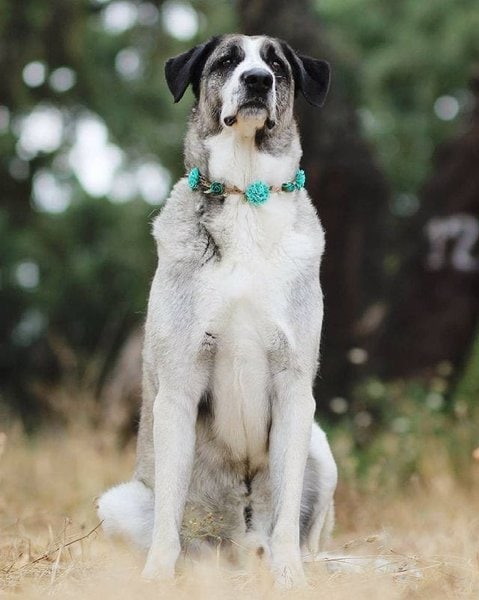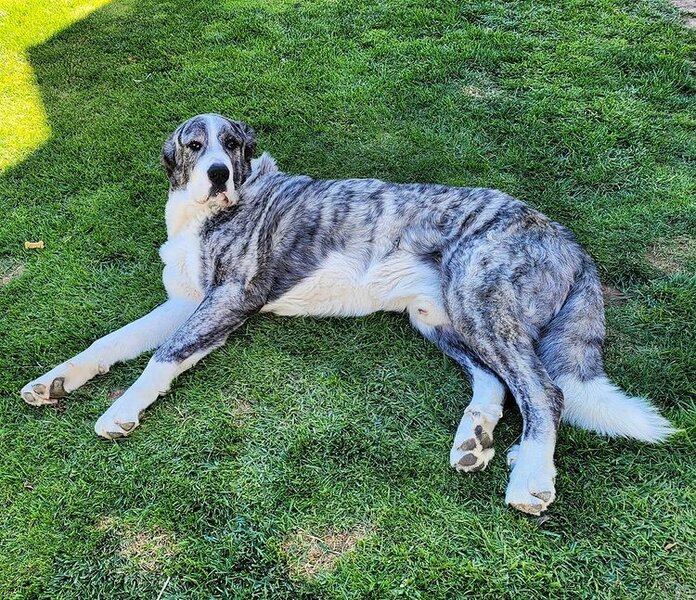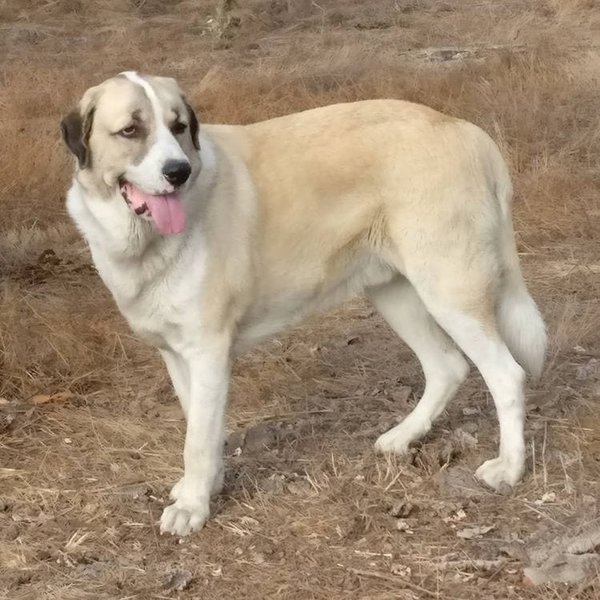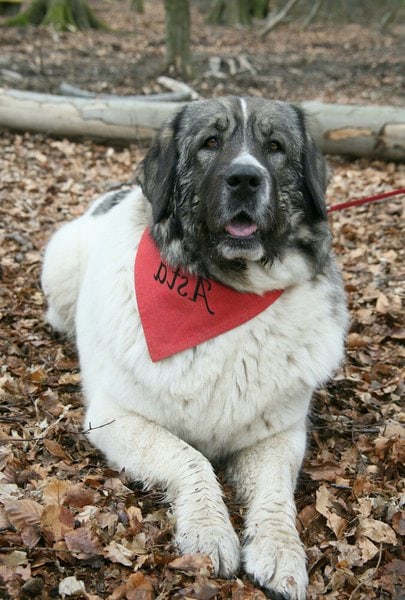Everyone thinks of Alentejo Mastiffs as being huge, with a tough exterior and intimidating bark. But for the most part, these dogs are intimidating only in size, not in temperament. They’re bred to be guard dogs, but they’re also bred to be loving companions. These dogs are calm and patient around small children, which is why they’ve become popular family dogs throughout Europe, especially among those who live on farms.
The Alentejo Mastiff, also known as Rafeiro do Alentejo, is one of the most ancient dog breeds with European origins, specifically in Portugal. One thing that makes this Portuguese Mastiff unique is that it is considered “primitive,” meaning their DNA is considerably close to the DNA of the very first dogs.
Many people also confuse this Portuguese Mastiff with a Neapolitan Mastiff or Beauceron because of their similar appearance. The most significant difference between these breeds is their ears. The Alentejo Mastiff does not have prick ears as other Mastiffs do but floppy ears.
Also, Rafeiros are larger than a Neapolitan Mastiff and smaller than a Beauceron. I’ll cover more interesting information from health issues to temperament to grooming. Before that, I’ll discuss how big Alentejo Mastiffs get.
How Big Do Alentejo Mastiffs Get?

Alentejo Mastiffs grow between 130 lbs to 170 lbs depending on gender and age! The average height for an adult male mastiff is 28 to 30 inches tall, while females tend to be 26 to 28 inches tall.
Female Mastiffs are usually smaller in height and weight compared to their male counterparts. This difference is common in most dog breeds.
What Do Alentejo Mastiffs Look Like?
This Rafeiro do Alentejo is long-bodied with a large head and small, dark eyes. Black fur surrounds their dark eyes, reaching to the eyebrows. Their somewhat wide muzzle tapers moderately down to the black oval nose.
The ears are wide at their base, tapering towards their tip, hanging slightly over the cheek area, giving them a more owl-like appearance.
The Alentejo Mastiff has a muscular neck with loose skin hanging, extending down into deep dewlap folds underneath the chin. This makes for some drool during feeding time!
Their forelegs are straight with large bone structures, while the hind legs are powerfully muscled. They usually carry their short tail over their back.
Coat Colors And Patterns
Alentejo Mastiffs are a large, muscular dog breed with an imposing physical appearance.
These canine buddies have thick fur coats that come in various colors, including coal-black, grayish-white, coffee brown, golden yellow, pale yellow, or cream-colored. The colors come either in brindle, fawn or with white markings.
They also sport short hair on their faces with long hair around their neck, making them look even more intimidating!
How Long Do Alentejo Mastiffs Live?

Alentejo Mastiffs typically live between 12 to 15 years, the average life expectancy for most large dog breeds.
However, many factors affect how long your Alentejo Mastiff lives, including size and weight. The average Mastiff dog begins to show signs of old age around 8 to 10 years when conditions like blindness, hearing loss, and arthritis appear.
During this time, it’s essential to make sure your Alentejo Mastiff continues to get the exercise they need every day. A sedentary lifestyle could result in weight gain and thereby shorten their life expectancy.
Common Health Issues
Portuguese Mastiffs are susceptible to developing heart disease and joint problems as they age. For example, dilated cardiomyopathy and hip dysplasia are typically found in this large dog breed.
So, keep an eye on your furry friend for any changes in its behavior, such as not wanting to eat or running around like a maniac.
Allergies are also common in the Rafeiro do Alentejo dog breed. So, if you notice that your dog is vomiting or has diarrhea, it can be a sign of an allergy that needs to be treated right away.
Call the veterinarian immediately if your dog is limping because it could be something serious. Hip dysplasia tends to run in this breed’s family. So if one parent had it, there is a fifty-fifty chance of their passing it on.
How To Take Care Of Your Rafeiro do Alentejo?
The Alentejo Mastiff needs daily exercise. They’re very active indoors and out, so they need to have an area that is safe for them to run around.
These canines are very active, so they will easily get through at least an hour of activity every day. However, some people suggest that two hours a day of moderate exercise is also appropriate for this large dog breed’s happiness and health.
How Do You Feed Your Rafeiro do Alentejo?
A high-quality diet can make all the difference to your Alentejo Mastiff. They need at least two meals per day, and those meals should have as much nutritional value as possible.
This breed’s ancestors lived on very little food, so they are naturally accustomed to eating just enough for survival. They will live a happier and healthier life with a proper diet, not just what’s necessary to survive.
Feed them at least 25% meat in their diet, with the remaining 75% in vegetables.
Pet Plate is an excellent option if you want to feed your dog with personalized meals. While they’ll enjoy the delicious human-grade ingredients, they’ll also receive nutrition-packed meals in meal-size proportions.
How Do You Improve Your Mastiff’s General Health?
Your Portuguese Mastiff might be eating a very balanced and healthy diet, but their body will still benefit from some extra vitamins.
Adding a multivitamin supplement to your dog’s food can help them stay fit and active. It also enhances their immune system, which is excellent for fighting any illnesses or diseases they may experience.
Consider giving your Alentejo Mastiff some dental water additives for improved dental care to further complement your doggie’s overall health. These additives will help to maintain a healthy set of teeth and give them a fresher breath which benefits the dog owner as much as the dog.
Temperaments Of Alentejo Mastiffs
These large canines are gentle giants that tend to be very quiet and calm. Most dogs are quick to show their displeasure when they dislike something, but the Alentejo Mastiff is more likely to keep it inside.
Alentejo Mastiffs are not difficult for dog parents who have experience with large breeds, as long as training starts young enough. Socialize them early to help them learn to be comfortable with people. This breed needs a lot of attention and comfort from its owner to stay happy throughout life.
This dog has been called an “old soul” because they take time to adapt well to changes around them—even if they involve new toys or furniture! Of course, once your Rafeiro do Alentejo is used to something, it will stay comfortable for a while.
Stubborn When Learning New Things
These Portuguese dogs can be stubborn and hold strong opinions. This makes it a challenge to teach them new tricks or involve them in games with the family.
Alentejo Mastiffs don’t like loud noise or chaos either; they need an owner who has patience and knows how to give lots of positive reinforcement during training sessions!

Socialization With Children
It’s a good idea to teach children how to approach and handle your Alentejo Mastiff, especially if they’re younger. It’s not that your pet will snap, but it’ll be uncomfortable for them if they aren’t supervised closely.
Alentejo Mastiffs don’t like it when kids pull tails or ears and other things of the sort, so make sure to teach children how to behave around this breed early on.
Grooming Tips For Alentejo Mastiffs
For Alentejo Mastiffs, the most crucial grooming tip is to brush their coats regularly. It will not only give them a shiny coat but also help prevent matting.
These Portuguese dogs do shed and tend to blow their coats twice a year. So they’re not hypoallergenic dogs.
Tip To Reduce Shedding
To reduce shedding, we recommend the Furminator Undercoat Tool for removing loose hair and undercoat without cutting or damaging your dog’s topcoat.
Furminators can reduce shedding by 60 to 80% and help distribute the natural oils in your Alentejo Mastiff’s skin and fur, making it shiny and healthy.
Bathing Routine
Use good quality dog shampoo and conditioner on your Alentejo’s coat once or twice per month, depending on how dirty they get.
If you are washing at home, make sure to thoroughly rinse off all of the soap, so it does not sit on your canine buddy’s skin for too long. This can cause skin dryness and irritation, or even worse—skin allergies!
Paws & Pals 6-In-1 Oatmeal Dog Shampoo is a gentle and effective oatmeal protein shampoo that soothes itchy skin, reduces shedding, and cleans your Alentejo Mastiff’s coat naturally without stripping its natural oils.
Also, it deodorizes and leaves the coat with a shiny finish. Use as often as needed to keep your Alentejo Mastiff clean and smelling fresh.
After bathing, it is best to dry with towels instead of hairdryers which could damage their sensitive ears if misused. Finally, trim nails every few weeks using electric clippers (never cut into their quick) and brush teeth daily to prevent bad breath.
Related Questions
How Much Does A Rafeiro Do Alentejo Cost? The Rafeiro Do Alentejo comes at a higher price compared to other breeds. The Rafeiro Do Alentejo costs between $500 and $1,500, depending on the gender or size desired. The price may also vary depending on the age, appearance, health, and location of the dog you will be purchasing.
Do Alentejo Mastiffs Swim? Yes, the Alentejo Mastiff breed is a strong swimmer and loves to play around in the water. This dog will love to swim with you in the pool or even a lake. They enjoy swimming so much that they can be found rescuing drowning sailors at sea!
What Is The Largest Portuguese Canine? The Alentejo Mastiff is the largest Portuguese canine and has an overall body length of about 45 to 55 inches when it reaches adulthood. This breed has a height of 27 to 31 inches, weighing up to 150 lbs. Males grow larger than females of this pooch breed as well.





